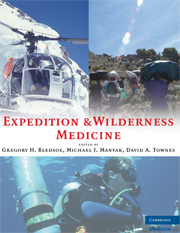Book contents
- Frontmatter
- Contents
- Contributors
- Foreword
- Preface
- Acknowledgments
- PART I EXPEDITION PLANNING
- PART II EXPEDITIONS IN UNIQUE ENVIRONMENTS
- PART III ILLNESS AND INJURIES ON EXPEDITIONS
- 24 General Medical
- 25 The Diarrhea of Travelers
- 26 Malaria: Diagnosis, Prevention, and Treatment for the Traveler
- 27 Wild Animal Attacks and Injuries
- 28 Snake and Arthropod Envenoming
- 29 Hazardous Marine Life
- 30 Expedition Toxicology
- 31 Environmental Injuries
- 32 Penetrating and Explosive Wounds
- 33 Drowning and Submersion Injury
- 34 Evaluation and Acute Resuscitation of the Trauma Patient
- 35 Principles and Practice of Expedition Wound Management
- 36 Expedition Eye Injuries and Disorders
- 37 Dental Medicine on Expedition
- 38 Foot Injuries
- 39 Expedition Orthopedics
- 40 Expedition Self-Rescue and Evacuation
- 41 Aeromedical Evacuations
- APPENDIX The Expedition Medical Kit
- Index
38 - Foot Injuries
from PART III - ILLNESS AND INJURIES ON EXPEDITIONS
Published online by Cambridge University Press: 05 March 2013
- Frontmatter
- Contents
- Contributors
- Foreword
- Preface
- Acknowledgments
- PART I EXPEDITION PLANNING
- PART II EXPEDITIONS IN UNIQUE ENVIRONMENTS
- PART III ILLNESS AND INJURIES ON EXPEDITIONS
- 24 General Medical
- 25 The Diarrhea of Travelers
- 26 Malaria: Diagnosis, Prevention, and Treatment for the Traveler
- 27 Wild Animal Attacks and Injuries
- 28 Snake and Arthropod Envenoming
- 29 Hazardous Marine Life
- 30 Expedition Toxicology
- 31 Environmental Injuries
- 32 Penetrating and Explosive Wounds
- 33 Drowning and Submersion Injury
- 34 Evaluation and Acute Resuscitation of the Trauma Patient
- 35 Principles and Practice of Expedition Wound Management
- 36 Expedition Eye Injuries and Disorders
- 37 Dental Medicine on Expedition
- 38 Foot Injuries
- 39 Expedition Orthopedics
- 40 Expedition Self-Rescue and Evacuation
- 41 Aeromedical Evacuations
- APPENDIX The Expedition Medical Kit
- Index
Summary
ANKLE SPRAINS AND STRAINS
A sprain is a stretching or tearing injury to the ligaments that stabilize bones together at a joint. Sprains are usually associated with traumas such as falling or twisting, and ankles are frequently the sprained or strained joint. If the patient cannot walk after a few minutes of rest or if they heard the infamous “pop,” you can be fairly certain they have a sprain. After a sprain occurs, the fibrous joint capsule swells and becomes inflamed, discolored, and painful. A strain is the overstretching of a muscle or tendon – but without the significant tearing common to a sprain. There may be bleeding into the muscle area that can cause swelling, pain, stiffness, and muscle spasm followed by a bruise. Strains can come from overuse, repetitive movements, excessive muscle contractions, or prolonged positions.
The most common ankle injury sprain is an inversion sprain and strain. The injured area is the anterior tailofibular and calcaneal fibular ligament just at the ankle joint on the outside of the foot. An eversion sprain, where the medial deltoid ligaments are injured, is less common. In some very serious trauma sprains, both the lateral and medial ligaments can be injured. An anterior drawer test, application of a tuning fork on the bony prominences, pain on palpation, palpation of a dell, or decrease in muscle strength can all be indications that there is a more serious condition and immediate transfer to an emergency room is indicated.
- Type
- Chapter
- Information
- Expedition and Wilderness Medicine , pp. 611 - 646Publisher: Cambridge University PressPrint publication year: 2008



